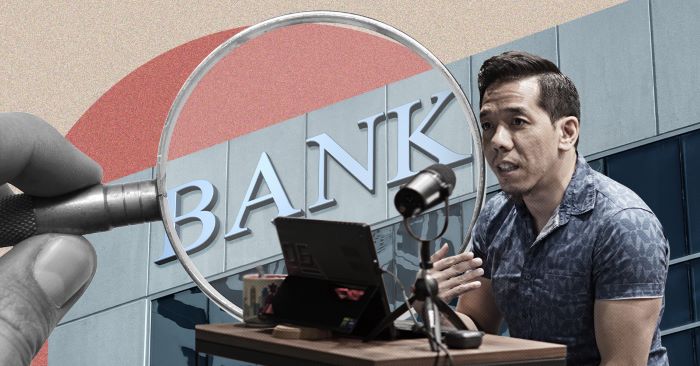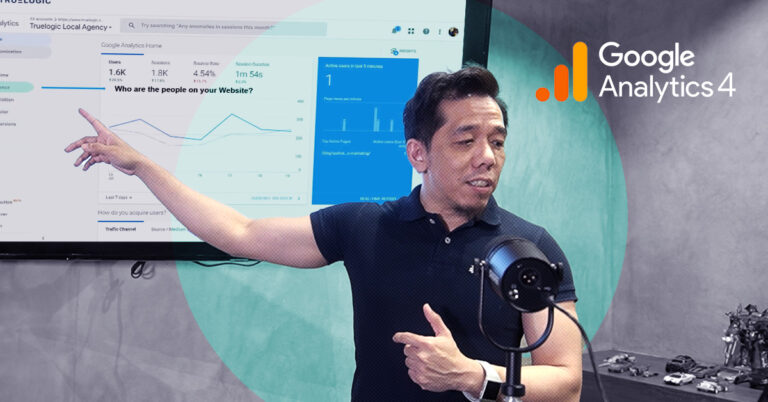Truelogic Episode 38 Recap: SEO for the Banking and Financial Industry

For SEO to be successful in the financial services industry, it is crucial to follow Google’s algorithm updates and best practices. Around 90% of users click on the first results that appear on SERP, which makes SEO for banks very important.
The competition is always high in the finance and banking sectors, especially with the rise of fintech but SEO can help financial brands stay on top. Let’s take a look at some effective SEO strategies without breaking the bank.
Berns San Juan: Welcome to the Truelogic DX Podcast. Today, we’re going to be taking a look at some of the key trends that leaders in SEO need to keep an eye on in the banking and financial industry, to be specific. Now, for those of you guys that follow Truelogic, you might be familiar. This is a playground that we’re used to playing in.
So I’m going to flex a bit. In this episode of the webinar. We’re going to talk about some proven strategies that allow banks and financial institutions to perform better in Google, convert more searchers across customers, and protect your brand while enhancing your online visibility when it comes to search. Let’s get started.
SEO for Banks in the Philippines
Berns San Juan: For SEO to be successful in financial services, it’s important that every brand, not just a bank, but I would say banks, in particular, follow Google’s algorithm updates, what the best practices are around I would say easily 64% in mobile is a bit higher. It’s about 80. 90% of users tend to click on the first results, specifically the first three results that appear on a search engine results page. This makes SEO super important.
But this really does make SEO super important when it comes to the banking and the financial industry. I think for most of the banks I’ve worked on, regardless of the marketing campaign they work on, the majority of the search traffic is always contributed by organic search. Now, had you talked to us six years ago, seven years ago, I would have said competition is like super easy. You optimize for a term, you’re there, you’re number one. But that’s not the case today with brands like BPI, BDO, Metro Bank, Security Bank, and UnionBank, all of them executing some form of digital marketing inside their own teams or whether they’re utilizing agencies.
The competition has gotten pretty tough. Like six years ago, if somebody told me they wanted to rank for online banking, I would have told them, “hold my beer.” That’s definitely not what I can say now, right? So let’s get into the flow of the discussion. Let’s meet the meat.
What is SEO for banking and the financial industry?
Berns San Juan: Let’s meet the meat of the conversation. So first off, what do we mean when we say SEO for banking or SEO for the financial industry? And what we really mean is just driving traffic from motivated visitors that come from Google right? Like that’s. All SEO is It’s about attracting users or attracting motivated users that begin from a search engine experience. That’s all SEO does. And there are really a lot of strategies that you can work on. Truelogic works with several banks in its portfolio, and I’ll have to say that none of the brands that we work with have the same goals, right? And so the strategies for SEO can be vastly different from one banking brand to another, and one financial brand to another. And the strategy that you employ depends on what the goal of that brand is.
Benefits of employing SEO for banks
Berns San Juan: For some brands, the goal is awareness, right? Improved branding, audience perception, and awareness of the brand or the product. I would say this would apply to brands that are attempting to enter the market.
Improved branding
I would say ING is attempting to enter the market and has already been in the market for a long time. But they do need help when it comes to gaining traction when it comes to the audience and whatnot. But this is what improved branding does, right? How do you measure if you’re doing well in terms of improving your branding, SEO-wise? I would say two things.
First, the direct traffic to your website increases. That’s the easiest measurement. And then the second one is, if you check on Google Trends, the volume of interest for your brand also increases, right? So where there might have been a hundred searches for, let’s say, UnionBank has a financial product called or Ubx has a digital product called Seek Cap right? Let’s start with this as an example.
If they saw CCAP begin with like 100 search volume in a month, successful branding, and successful awareness would mean that the term Seek Cap is S-E-E-K-C AP. It means that that term gets a search volume of 200, 500, and 1,000. And this is how they know their SEO is impacting their branding, right? For larger brands, I think brand awareness should not be a goal, right? Like, if you’re a Metro Bank, you’re Metro Bank. People don’t just know your name, they probably know your tagline. If you’re a BDO, you’re BDO. People don’t know your name. People probably also know your tagline. And if you’re a BPI, you’re BPI.
So I don’t think such a top-level strategy needs to be done by big brands. I think they ought to do it when they’re introducing new products to the market, but if they’re not introducing new products so an example would have been BDO Nomura, right? Or BPI Invest. Like, these are things that would require awareness exercises, which means they want to check how many times people put in a query for BDO Nomura, and how many times people put in a query for BPI invest. And as that grows, then they know they’re driving awareness for that specific product.
Increased traffic
Now, the easiest and, you know, the goal that everybody wants is always, I want to increase my traffic. And in the banking industry, there will be two players. There will be extremely strong players, and there will be extremely weak players. Like, they really are polar opposites, because if you’re going against the institutional banks, you’re talking about banks with domains that are, like, 20 years old, with thousands of domains that have mentioned them, that are pointing backlinks to them.
They probably have authority scores in the 50s or the 60s. Those are, like, what page ranks of six, seven? Those are immensely high, right? And so if you wanted these pages to rank for any keyword, they probably could, just because of the sheer power of the domain. But when you’re working on big brands, increasing traffic is pretty easy, right? Like, Truelogic, I can say we up the traffic to a banking client by 1.5 million visitors per month. Upping the traffic to banking by, let’s say, a quarter of a million visitors monthly is also not difficult if you’re working with an established brand. You do have to be craftier when you’re working with a smaller brand.
Let’s say that ING was a client, right? Is your footprint in the Philippines not huge? And so it’s a question of where can I inherit authority from? Like, can I borrow authority from the parent brand? Can I get a link back that points to the Philippines? Should I compete for online banking keywords, for ATM, for a savings account, or for a checking account? Or should I compete with more niche terms like high-yield savings accounts, right? High-yield savings account, high-yield time deposit. Those might be the terms that I would gun for if I was competing with the top brands. The other thing that I would do is as many resources as big players in big banking brands put in.
But an increase in traffic for banking is actually not difficult. If I were to say from the point of experience, in terms of difficulty, I would have rated this, like, a three out of ten today. It might be a five to six out of ten, which is not extremely difficult. It’s still relatively easy.
Better conversions
Now, the challenge is, over the years, and I would say maybe I might not be exaggerating, but over the past eight years, I think banks have digitally matured, and they’re not just interested in, oh, I want awareness. Oh, I want traffic. Now they’re actually saying, I want conversions, and I want to know the path that that conversion. I want to know how I acquired them.
Did I get them from an ad, or did I get them from Facebook? Did I get them from an email campaign? Did I get them from organic? Right? And I think this is super fair. Me, I think when brands tell me when banking brands tell me I want customers, I’m always thinking, well, great. I want you to have customers because if you don’t get more customers, you’re probably not inclined to continue to work with me. And so when we say better conversions, I will split acquisition into three things. I’ll split the acquisition into three things. The first acquisition your website acquires is what you call audiences.
If you’ve got a person visiting your car loan page, for example, their problem is not a credit card, right? They’re on a car loan page because they want to have a car. They want to buy a car. This is the problem they’re trying to solve. And so what you can do is you can bucket these non-identified visitors to your website in an audience, in your analytics.
You can group them together and define them as an audience. Like, here are my car loan visitors. Here are my auto loan visitors. So that if you want to drive a push towards auto loans, you’re not throwing 100, 200,000 pesos on all of the Philippines. You’re not throwing half a million on all the Philippines.
Remember, your products don’t talk to everybody, right? Like, that’s never the goal. If your brand, if your product is trying to sell everyone, it’s trying to sell no one, right? So the first acquisition you make is your audience, the visitors to your website, where you classify them, and where you segment them.
Now, start a conversation and then ease them in into a ten-field form, an eight-field form, and a 20-field form. But at least start a conversation, get them to trust you, and then that’s when they become comfortable giving you more information. But don’t, right off the bat, attempt an acquisition where your forms have 8, 10, or 12 requirements for them to fill out. Remember, users, feel that their information has value. Right. And so don’t expect that just because you’ve got that form there, they’re just going to fill it out just like that. It doesn’t work that way. So I would say, have a shallow acquisition. Like getting your user’s first name, last name, and email address. That allows you to target them with meaningful content. Get them to subscribe to your newsletter.
But the other thing is then to have them, when they are true conversions like once you’ve convinced them enough, you get them past the information, you get them past the consideration and they’re in the preference phase of their buyer’s journey. Then give them the twelve forms, the form with twelve fields. Then give them the 20 field form, but don’t give them the 20 field form as step one.
And then ultimately the last conversion is actually turning them into actual customers. Where somebody actually avails of a banking loan. Somebody actually takes a home loan from you, somebody actually applies for a credit card with you. And try to make as many of these as electronic as possible. Right? Try not to get somebody to I mean post-COVID, right? One of the impacts is we don’t like going into establishments anymore. Right? We don’t like going into establishments anymore.
Definitely not banks. Not when we can get away with it with our app, not when we can get away with it with online banking. So your ability to cross-sell them in the facility is not very high anymore. So I would say the ultimate conversion is that I will mention one more type of conversion. If you are a bank and you’re utilizing an app, an app download is an acquisition.
Because what is an app user then? A logged-in web user, right? Your app user is just a web user where you know all of their information. Okay, so those are some of the things, and actually, those have been some of the goals that we’ve had to deal with when it comes to working with banks.
Challenges in SEO banking
Velocity
Berns San Juan: The first challenge for SEO, for anything digital in any bank, is always velocity because it’s a highly regulated industry there’s a lot of control because there are usually half a dozen decision-makers.
The decision-making can be slow, but what I will say, is either find a way to speed it up or learn how to front load all the decisions that need to be signed off on so that they can get a sign-off really quickly. Don’t make your senior decision-makers. The marketing team goes through an Iterative and reiterative process. Like, you reiterate your processes over time, but your senior managers don’t have the time to do that, right? If you set expectations on a project plan and say, okay, here are the things that we’re going to do, here are where we need your sign-off.
One of the ways to overcome that is to front-load a lot of the top-level decision-making so that you can just give it a go.
Competitive landscape
The second challenge is the competitive landscape. For the past eight years, banks have been getting better and better and better at their digital. I would rate the competitiveness in the banking industry to within about a six or a seven. It’s starting to get pretty competitive.
Lead generation
The next one is another challenge, which is focusing on lead generation, right? I think a lot of banks are still too focused on branding. I think they’re still too focused on other cosmetic metrics that they’re failing to be obsessive about the metric that matters, the conversions. And so that’s another challenge that we experience with banks.
Analytics
One of the bigger challenges that I usually experience, is messy analytics. If I wanted to get an overview of how a bank was performing. Like, once we get access, most of the time I see it’s not unusual for me to see a dozen, two dozen views, half a dozen filters inside a bank, three, or four different agencies utilizing tag manager in different ways, and whatnot. And I think in the same way that banks have great top-down controls, you have to have the same thing for a bank, right? Like, if you have great top-down control over your financial processes, you ought to have the same discipline when it comes to your digital meaning you have to have specific rules of governance for OK, how do you manage the website and what are you allowed to update and when does that require upper-level approval?
And what kind of protocols do you follow when you create a tag manager? When you run a campaign, what do you need to set as default goals? So I would say just basic governance.
Stricter content quality requirements
On the agency side, I would say the other challenge is actually correct content quality requirements. And this I think I fully understand because banking is a highly regulated industry in the Philippines. Actually, I’m proud of how regulated our banking industry is. This is why there are no runs on our banks and whatnot. But there are very strict quality requirements when it comes to banks. And that’s why I think content creation for banking is more collaborative than in any industry we work in. Because in most of the industries we work in, it’s rarely as regulated as a bank. I think banks are probably some of the most regulated ones we work with.
Various SEO strategies for Banks
User Intent
Build your SEO strategy from the perspective of user intent. Don’t build it from the perspective of loan X. Like, I’m going to drive X amount of traffic to loan X. I think every SEO strategy has to be driven by what’s the problem of the user and how does your product solve that problem? I think all SEO, has to be the foundation of SEO.
When I see brands produce content, banking brands specifically, I still see a lot of product bragging. Like, meaning they talk about, oh, here’s my product, here’s why it’s great, here’s this, there’s that. And that doesn’t work. It just doesn’t work. So when you’re optimizing for user intent, don’t just brag about what your product A features, features, features, features; product B features, features, features.
Your content has to be more than that. Your content has to talk to the user and how it solves their problem. I think this is why I can’t even over-emphasize how important it is that banks understand their customer avatars. Like, what does your typical walk-in client, what does your typical online client look like, behave like dress like, and what kind of content do they read? Because you need to understand what their problems are and how they intend to solve those problems.
Optimizing valuable keywords
The next one is optimizing for valuable keywords. I do think in the banking industry, there’s a lot of obsession with brand names and sometimes not enough obsession with the commercial equivalent. It doesn’t matter what you call your product, the users will search based on what they understand about that product. So I’ll give you guys a great example.
When time deposits were a thing and mutual funds were a thing, eventually they all got changed to UITFs and then all the banks just started calling the products UITFs and they essentially removed all mutual funds. But that’s like ignoring all of your Gen Xers and your older millennials who still understand funds like that to be mutual funds, right? So if the search volume is still in mutual funds, I would still say mention it in your content, then optimize it for it and then bring them to your UITF products. So doesn’t matter what you call the product, it matters what your audience thinks the product is. So do your users look for a car loan or do they use an auto loan, right?
Like, do they query as an auto loan, or do they use a car loan? Do they use a housing loan or do they use a home loan? But how do your users actually perform the searches? Now, some of you guys might ask, but what if my users use both auto loans and car loans? Then use both. If your users use both, then use both.
Related: How To Improve SEO Rankings in 2024
Leverage proper schema markup for all web pages
The next one is do you leverage schema and markups for your web pages? I’ll give you guys a great example of something that often gets missed the local schema on branch pages. Most of the time in branch pages, I just see a list of addresses of all of the different branches and then the address is entered as text.
But there is no markup. There is no HTML that declares that this is a street address, that’s their phone number, this is the city they’re in, that’s the locality they’re in. And the markup is such an easy way for you to rank in the map results, in the snack pack, and in the blended result. So this is another strategy that I think gets missed a lot.
Focus on topical relevance and context when creating content
In short, don’t produce content because your content calendar says you got to produce content, right? What kind of problem is that content trying to solve? Produce content because there’s a purpose you’re trying to rank for the informational version of a commercial page, you’re trying to push semantic relevance for a commercially intended page, and so on and so forth.
Mobile responsiveness
Chances are 60% or more of your users are utilizing mobile devices to educate themselves about the products or services that are offered by your bank. Is your content friendly to their mobile devices? This can have a big impact in terms of whether you will perform or not because the Google index is mobile first.
Local SEO
Right now related to proper markups is local SEO and local SEO has more to do with the stuff you do on-site, like for example, the local schema. But part of local SEO is optimizing for your Google business profile and then claiming your other listings on other business listing websites. Consider it as also an easy form of link building because when you list yourselves on yellow pages, you get a link. When you list yourselves on Apple Maps, you get a link. When you list yourselves on different business listing sites, you get a link back, Yahoo, local, and so on and so forth.
Link Building
This is always a strategy, but if you’re an authoritative bank, you don’t really need this. Link building is one of the more expensive strategies to do. If you’re doing PR, chances are you are naturally acquiring links yourself as well. So I wouldn’t focus 80% of your attention on this, but what I will say is pay attention to the new links you acquire and the links that you have that decay and just try to make sure that you are acquiring new backlinks, that you are acquiring new mentions as fast as you’re losing them. Don’t freak out when you lose a link.
That’s like the natural lifecycle of a link. Like you earn links and you lose links. That’s just the natural way the organic internet works.
Visual content
Whenever you can, try to pepper images, try to embed videos in your content stuff that makes it easier for your users to understand the value of your product and your service.
In an experiment we did six years ago, we know for a fact that pages with multiple content formats that visual content get scanned and indexed or get crawled and remembered by Google more frequently than pages that are just all text. So try to make your content what I would call scannable or snackable. But try to make your content scannable so that the user can zero in on the content they need. And make sure that the images you’re using are contextually related to the product that you’re pushing inside that page.
Security and privacy
Https like, if your website is if it’s an old domain, try to make sure that you have nothing redirecting. Back to the nonsense version of your site. I still encounter this every now and then. Because established brands, institutional brands, tend to have domains that are decades old, right? And somewhere along the way, somebody was less than super diligent when it comes to the redirections. But try to make sure that none of your nonsecure pages can still be found. That’s what I’ll say for security.
Now for privacy. Every time I login into any website, not necessarily a bank, nothing drives me crazier when they declare they use cookies and the only button, the only thing I can do is accept. That’s not acceptable, right? I think the best websites are the ones that allow their users to decline. That like, what if I don’t want my data collected? What if I don’t want my data monetized? Sooner or later, if you just force users to accept, then guess what? Most users will view you from an iPhone, which means you won’t be able to capture any data anyway.
Make a competitor analysis
Next, make sure that you check on your competitors. You may need a pro to help you figure this out, but make sure that you’re monitoring the competitors. SEO is very relative. You are number one because you’re better than the person at number two. You’re number three because number one and number two have better web pages than you, right?
]And take better with a grain of salt. That’s like a bunch of stuff. But SEO is a very relative game. And the way to stay on page one and on positions one, two, and three is to make sure that you’ve got the first-best, second-best, or third-best web page out there, right? So make sure you’re paying attention to your competitors.
Get a pro to read your data for customer insights
If you are a brand that works with six agencies, try to get your agencies to all to speak the same language. Trying not to get one agency to report in one way, another to report in another way, and another to report in another way. Get a pro to read your data. In fact, if a bank were to have its own digital team, the first one that I would tell them to recruit is their data science person.
That is the first person that they should be talking to, or that’s the first person they should be hiring. Because you have to be interpreting your data in the same way. And get a pro to read your data. Try not to wing it, because you probably will do it wrong. And I think if you think a pro is expensive, wait until you hire an amateur.
And with that, I’m going to wrap up this episode. I wanna thank our friends at Podmachine for making this possible. And don’t forget to subscribe to our Spotify, Google, and Apple accounts and set up your alert for new episodes. Give us a shout-out on social media, and if you have any comments regarding what we talked about or any topics you want us to explore, or people you want us to talk to, feel free to drop us a message and I’ll see you for our future episodes.










